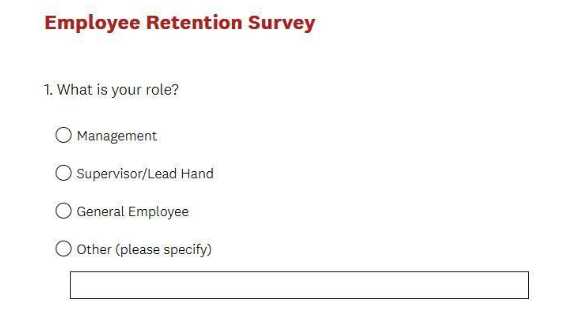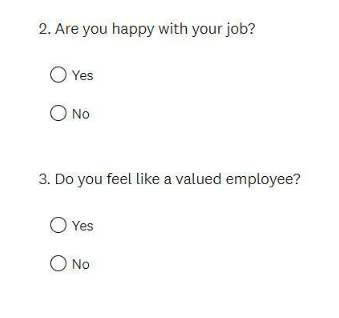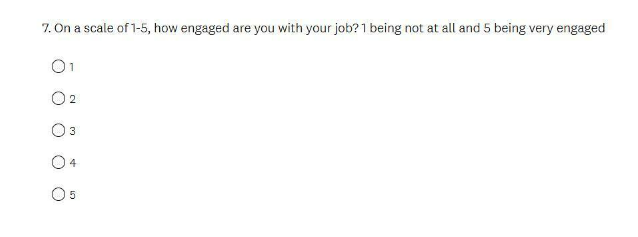20 Best Employee Retention Survey Questions

To stay or not to stay…
That is the question.
In fact, that may be the major concern tormenting every second worker on your team at this very second. Why so? It’s not a complicated math calculation. Just look at the employee turnover statistics: roughly half of employees (51%) actively search for new jobs.
Yet, it’s tough to retain your employees if you can’t tell the reason why they may be willing to jump off your “ship” and leave you. Is it all about isolation and disconnection from colleagues due to insufficient team-building activities? Or do they burn out at work or simply want to change their career paths? Who knows?
Well, you can source the exact answers from your workers via an employee retention survey.
However, picking the right employee retention survey questions is the most challenging part for many. This article saves you from the headache of googling and sorting them out. At the end, you can also find some bonus tips on running employee retention surveys.
Follow the route we’ve marked.
- 20 Employee Retention Survey Questions in Blocks
- Block #1. Employee Retention Questions Determining Baseline Engagement
- Block #2. Employee Retention Questions Measuring Job Satisfaction and Motivation
- Block #3. Employee Retention Questions Gauging Work-Life Balance
- Block #4. Employee Retention Questions Evaluating Leadership Effectiveness
- Block #5. Employee Retention Questions Assessing Professional Growth
- Bonus Read: 3 Tips on Conducting an Employee Retention Survey
- What’s Next After the Employee Retention Survey?
- Author Bio
20 Employee Retention Survey Questions in Blocks
Block #1. Employee Retention Questions Determining Baseline Engagement
As job disengagement increases over time, your workers may lean toward resigning. On average, 12% do so because they are disengaged at work.
Check your team’s engagement levels with the following questions:
- Please rate your engagement at work on a scale of 1 to 10.
- How well do you communicate and collaborate with your colleagues on tasks and projects? (1 = Poorly, 5 = Extremely well)
- Do you engage with your teammates during physical or virtual team-building events?
- Can you describe a recent experience where you felt highly (dis)engaged at work?
Note: Some questions may overlap with those in your employee engagement survey. If so, replace them to avoid repeating the same.
Block #2. Employee Retention Questions Measuring Job Satisfaction and Motivation
Compared to disengagement impacting the turnover rate in organizations, dissatisfaction is even grimmer: 81% of employees consider quitting because they are unhappy with their jobs. That is why they may lack motivation to perform tasks.
Figure out if that’s the case at your company, and if yes, discover how you can boost employee satisfaction and motivate your team.
- On a zero-to-ten scale, how satisfied are you with your current role?
- What would make you happier at work?
- How likely are you to recommend our company as a great workplace (1–10)?
- What keeps you motivated to do the job, and what demotivates you?
Logan Mallory, Vice President of Marketing at Motivosity, believes keeping a regular record of employees’ motivators (what drives) and demotivators (what discourages) is critical for a loyal workforce. “Knowing what works and what doesn’t, you can add more motivational drivers, like a reward or promotion, and remove demotivational factors, such as micromanagement or exclusion.”
For example:
Suppose recognition is the best method to motivate your employees. In that case, you can celebrate their achievements and milestones with awards or workplace diplomas, like the “Years of Service Award” or the “Diploma in Leadership.” Proudly displayed in diploma frames at your workers’ homes or corporate offices, they will symbolize your deep appreciation for their hard work and dedication.
Block #3. Employee Retention Questions Gauging Work-Life Balance
According to Thomas Medlin, Co-Founder at JumpMD, another primary reason for high turnover is an unhealthy balance between professional and personal life. “A poor work-life balance leads to neglected personal interests, chronic stress, and complete exhaustion (burnout), pushing employees to the edge. It’s also worth mentioning that the most vulnerable occupations with the highest burnout rates are healthcare professionals, social workers, and educators, among others.”
Consider incorporating several employee well-being questions into your employee retention survey to determine whether the work-life balance is enough for your employees.
- Does the current workload impact your personal life?
- On a 1-to-10 scale, how often do you experience stress or burnout in the workplace?
- What could help you create a better balance between work and life?
- To what extent do you feel your manager supports your efforts in achieving the work-life balance? (1 = Not at all, 5 = Completely)
Block #4. Employee Retention Questions Evaluating Leadership Effectiveness
“Employees quit bosses, not jobs” isn’t just a saying.
It’s the bare truth: 57% of people left their jobs because of their managers, and 32% seriously thought about such a step in light of poor leadership.
Let’s take your leadership team and verify its managerial force and usefulness with the following employee retention survey questions:
- On a scale of 1 to 10, how effectively do leaders communicate the company’s mission and core values?
- Have you received enough recognition and appreciation from the manager?
- Can you describe a case of successful conflict resolution by your team leader?
- What aspects of leadership do you find the most effective in building a positive work environment?
Block #5. Employee Retention Questions Assessing Professional Growth
Yet again, let’s turn to statistics: 74% of employees say they would change companies in favor of those that offer additional education or career advancement.
Ask your workers about their career trajectory and let them carve out their individual paths:
- Do you have a clear picture of your professional development plan?
- On a scale of 1 to 5, rate your agreement with the statement: “I have access to training materials and resources necessary to grow in my role.”
- What additional skills would you like to master to advance your career at the company?
- Is there any specific training you would want to attend for your professional growth?
Alternatively, Grant Aldrich, Founder of OnlineDegree.com, recommends preparing a list of accessible programs or courses for your employee retention survey. “With a ready-made range of learning and development options, you can better plan your L&D budget and give each worker freedom to personalize the career development path by choosing the preferred course or program.”
For example:
For a sales representative, you can list a customer orientation course, a help desk certification, and social media communication training, among other programs.
Bonus Read: 3 Tips on Conducting an Employee Retention Survey

Keep it confidential.
Roman Zrazhevskiy, Founder & CEO of MIRA Safety, insists on maintaining confidentiality and never forcing your staff members to mention their names in employee retention surveys. “Survey anonymity ensures your workers’ psychological safety, protects their privacy rights, and encourages honest feedback.
You may require indicating the job role if it’s necessary for a better understanding of survey results.”
Look at how the Huron Manufacturing Association (HMA) does that.

Keep it diversified.
It would be best to diversify question types in your employee retention survey by mixing up the following to capture insights from a broader scope:
- Yes/no (close-ended) questions
- Zero-to-ten rating scale questions
- Open-ended questions
- Likert-scale questions with “strongly agree” and “strongly disagree” extremes
- Ranking questions (e.g., Rank these workplace perks based on their importance to you.)
For example:
HMA uses several close-ended questions.

And a scaled question, among others.

Keep it brief and simplistic.
Jerry Han, CMO at PrizeRebel, explains why it matters. He says, “Shorter surveys are less time-consuming and overwhelming. They boost employee participation rates. On the contrary, lengthier surveys typically lead to fatigue and boredom. Respondents may get easily tired or disengaged and drop the survey without finishing it till the end.”
A widely accepted norm is 10-15 employee retention survey questions.
For instance, HMA has eight questions taken from different categories.

What’s Next After the Employee Retention Survey?
Your final move is to analyze the results and spotlight areas for improvement. Based on the outcomes, you can create a strategy to reduce the turnover rate and forge employee loyalty bonds as strong as tempered steel.
But hey, you don’t have to embark on this journey alone. The Outback team can become your masterful co-pilot, helping you navigate the tasks. Contact Outback and work out something extraordinary for your employees together, whether to engage your team in first-class training or craft a captivating team-building activity.
Author Bio
Catherine Schwartz is an author who specializes in employee well-being and engagement.




Comments